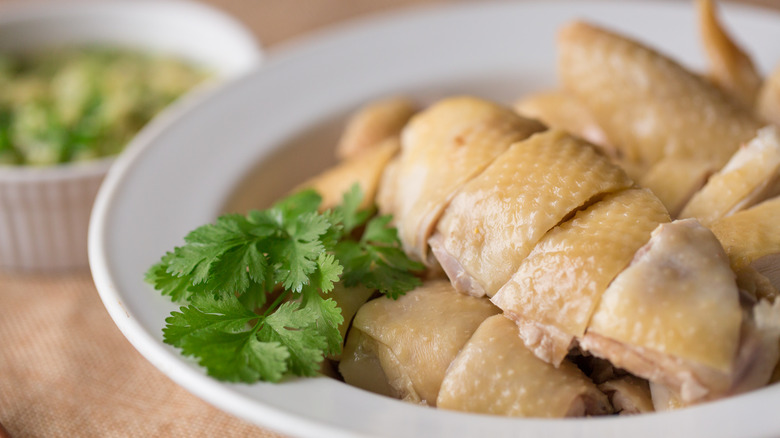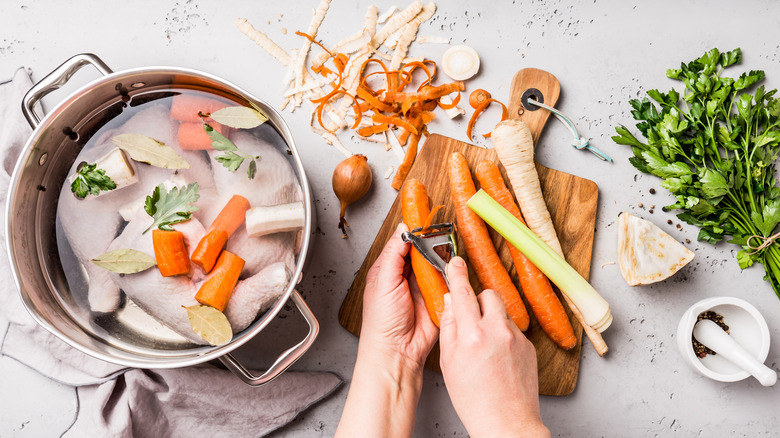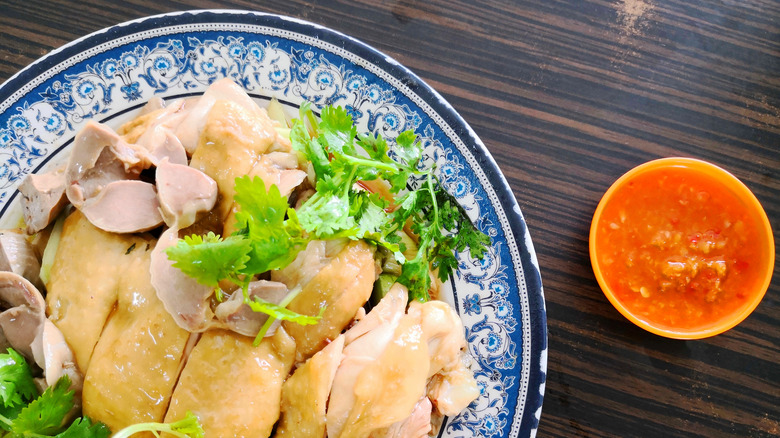You've Been Poaching Chicken All Wrong
Although it's been a hot minute since the low-fat craze swept the nation — anyone else remember mom's arsenal of low-fat cottage cheese, skim milk and cardboard Snackwell's cookies? However, the technique of poaching that utilizes no additional fats, is a holdover from that era that we can get behind. Poaching is a way to cook meats, fish, and vegetables in a flavorful liquid, and it's infinitely versatile because you can customize your poaching broth to your personal tastes and how you plan to serve the cooked ingredients (via The Food Network).
But if you have bad memories of bone dry poached chicken breast, you're not alone. Though poaching is a simple technique, there are ways in which it can go awry, with overcooking being one of them and too-high heat being another, per Bon Appétit. But once you nail poaching, you'll be able to reliably serve up tender, flavorful vegetables, fish, and, especially, chicken.
Flavoring the liquid for poached chicken is important
One mistake people make when they set out a-poachin' is to heat up a pot of plain old water. When it comes to poaching, the flavor you put into the broth is largely responsible for the flavor your cooked chicken will take on, so don't be shy! Think of what you do when you make soup, and apply a similar process, adding tasty vegetables and herbs to your broth (and don't skimp on the salt, either). According to The Food Network, this broth is called a court-bouillon, or "short broth," because it mimics the technique of making a deep, flavorful broth, just in a shorter amount of time.
These broths are infinitely customizable, according to the network. If you plan to shred your poached chicken into a bowl of cold sesame noodles, for instance, why not flavor your poaching liquid with plenty of ginger, garlic, and scallions to match those flavor profiles? Or if your bird will end up alongside a plate of marinara noodles, go ahead and add aromatics such as garlic, basil, and parsley to your broth.
Poach your chicken, don't boil it
One more thing, it's vitally important when poaching to learn to recognize the difference between simmering liquid and boiling liquid, per Bon Appétit. When poaching chicken, you want to go for the former — low, slow, and gentle heat characterized by small, slow-moving bubbles that only occasionally break on the surface of the liquid (via Cook's Illustrated). If you let that liquid boil — at a higher heat, with active bubbles — you'll be cooking your chicken at too high of a temperature, and you'll end up with dry, stringy flesh that even the most generous application of mayo won't hide in a chicken salad.
Once you've got your flavorful simmering liquid ready to go, make sure you don't overcook your chicken. A whole poached chicken will take anywhere from an hour to an hour and a half to fully cook (via The Spruce Eats), while parts such as chicken breasts and thighs will be ready in as soon as 15 minutes, according to Martha Stewart. Fully cooked poached chicken will still be very tender but no blood will come out when testing with a knife. So, there you have it, a foolproof guide on how to poach chicken. Your life in the kitchen might never be the same again.


